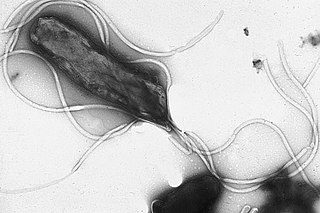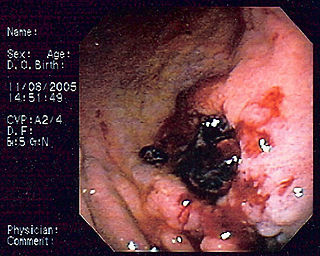
The medical uses of silver include its use in wound dressings, creams, and as an antibiotic coating on medical devices. Wound dressings containing silver sulfadiazine or silver nanomaterials may be used to treat external infections. The limited evidence available shows that silver coatings on endotracheal breathing tubes may reduce the incidence of ventilator-associated pneumonia. There is tentative evidence that using silver-alloy indwelling catheters for short-term catheterizing will reduce the risk of catheter-acquired urinary tract infections.

Helicobacter pylori, previously known as Campylobacter pylori, is a gram-negative, flagellated, helical bacterium. Mutants can have a rod or curved rod shape, and are less effective. Its helical body is thought to have evolved in order to penetrate the mucous lining of the stomach, helped by its flagella, and thereby establish infection. The bacterium was first identified as the causal agent of gastric ulcers in 1983 by the Australian doctors Barry Marshall and Robin Warren.

Helicobacter is a genus of gram-negative bacteria possessing a characteristic helical shape. They were initially considered to be members of the genus Campylobacter, but in 1989, Goodwin et al. published sufficient reasons to justify the new genus name Helicobacter. The genus Helicobacter contains about 35 species.

Methotrexate (MTX), formerly known as amethopterin, is a chemotherapy agent and immune-system suppressant. It is used to treat cancer, autoimmune diseases, and ectopic pregnancies. Types of cancers it is used for include breast cancer, leukemia, lung cancer, lymphoma, gestational trophoblastic disease, and osteosarcoma. Types of autoimmune diseases it is used for include psoriasis, rheumatoid arthritis, and Crohn's disease. It can be given by mouth or by injection.

Carboplatin, sold under the brand name Paraplatin among others, is a chemotherapy medication used to treat a number of forms of cancer. This includes ovarian cancer, lung cancer, head and neck cancer, brain cancer, and neuroblastoma. It is used by injection into a vein.

Cisplatin is a chemotherapy medication used to treat a number of cancers. These include testicular cancer, ovarian cancer, cervical cancer, bladder cancer, head and neck cancer, esophageal cancer, lung cancer, mesothelioma, brain tumors and neuroblastoma. It is given by injection into a vein.

In chemistry, an ionophore is a chemical species that reversibly binds ions. Many ionophores are lipid-soluble entities that transport ions across the cell membrane. Ionophores catalyze ion transport across hydrophobic membranes, such as liquid polymeric membranes or lipid bilayers found in the living cells or synthetic vesicles (liposomes). Structurally, an ionophore contains a hydrophilic center and a hydrophobic portion that interacts with the membrane.

Penicillamine, sold under the brand name of Cuprimine among others, is a medication primarily used for the treatment of Wilson's disease. It is also used for people with kidney stones who have high urine cystine levels, rheumatoid arthritis, and various heavy metal poisonings. It is taken by mouth.

Furazolidone is a nitrofuran antibacterial agent and monoamine oxidase inhibitor (MAOI). It is marketed by Roberts Laboratories under the brand name Furoxone and by GlaxoSmithKline as Dependal-M.

MALT lymphoma is a form of lymphoma involving the mucosa-associated lymphoid tissue (MALT), frequently of the stomach, but virtually any mucosal site can be affected. It is a cancer originating from B cells in the marginal zone of the MALT, and is also called extranodal marginal zone B cell lymphoma.

Gold-containing drugs are pharmaceuticals that contain gold. Sometimes these species are referred to as "gold salts". "Chrysotherapy" and "aurotherapy" are the applications of gold compounds to medicine. Research on the medicinal effects of gold began in 1935, primarily to reduce inflammation and to slow disease progression in patients with rheumatoid arthritis. The use of gold compounds has decreased since the 1980s because of numerous side effects and monitoring requirements, limited efficacy, and very slow onset of action. Most chemical compounds of gold, including some of the drugs discussed below, are not salts, but are examples of metal thiolate complexes.

Primary gastric lymphoma is an uncommon condition, accounting for less than 15% of gastric malignancies and about 2% of all lymphomas. However, the stomach is a very common extranodal site for lymphomas. It is also the most common source of lymphomas in the gastrointestinal tract.

Auranofin is a gold salt classified by the World Health Organization as an antirheumatic agent. It has the brand name Ridaura.
Triplatin tetranitrate is a platinum-based cytotoxic drug that underwent clinical trials for the treatment of human cancer. The drug acts by forming adducts with cellular DNA, preventing DNA transcription and replication, thereby inducing apoptosis. Other platinum-containing anticancer drugs include cisplatin, carboplatin, and oxaliplatin.

Satraplatin is a platinum-based antineoplastic agent that was under investigation as a treatment of patients with advanced prostate cancer who have failed previous chemotherapy. It has not yet received approval from the U.S. Food and Drug Administration. First mentioned in the medical literature in 1993, satraplatin is the first orally active platinum-based chemotherapeutic drug; other available platinum analogues—cisplatin, carboplatin, and oxaliplatin—must be given intravenously.

Hydrazine sulfate, more properly hydrazinium hydrogensulfate, is a salt of the cation hydrazinium and the anion bisulfate (hydrogensulfate), with the formula N2H6SO4 or more properly [N2H5]+[HSO4]−. It is a white, water-soluble solid at room temperature.
The respiratory tract antimicrobial defense system is a layered defense mechanism which relies on components of both the innate and adaptive immune systems to protect the lungs and the rest of the respiratory tract against inhaled microorganisms.
Platinum-based antineoplastic drugs are chemotherapeutic agents used to treat cancer. Their active moieties are coordination complexes of platinum. These drugs are used to treat almost half of people receiving chemotherapy for cancer. In this form of chemotherapy, commonly used drugs include cisplatin, oxaliplatin, and carboplatin, but several have been proposed or are under development. Addition of platinum-based chemotherapy drugs to chemoradiation in women with early cervical cancer seems to improve survival and reduce risk of recurrence.
Ruthenium anti-cancer drugs are coordination complexes of ruthenium complexes that have anticancer properties. They promise to provide alternatives to platinum-based drugs for anticancer therapy. No ruthenium anti-cancer drug has been commercialized.

Lobaplatin is a platinum-based antineoplastic metallodrug approved exclusively in China for the treatment of small cell lung cancer, inoperable metastatic breast cancer and chronic myelogenous leukaemia. The drug is a third-generation analogue of cisplatin, the first globally approved and widely used platinum-based anticancer drug.















